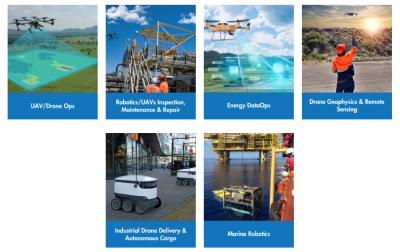Before the advent of uncrewed technology, inspections of power lines and other energy industry assets was time consuming and expensive. In addition, manual inspections often put workers at risk, and the data derived from visual observations could be less than complete or fully accurate.
Companies like Volatus Aerospace have changed all that by introducing uncrewed systems that have brought amazing efficiencies and increased safety to inspection work. Those benefits get richer all the time as companies find new and better ways to conduct inspections. One such example is in the nascent field of UV corona detection. Used in high-voltage transmission lines and infrastructure, UV corona detection enables inspectors to see the unseen with the goal of early detection and prevention of catastrophic damage to critical infrastructure.”
Volatus’ Charlie Rohan, an expert in utilizing COtS and customized UAS platforms to help clients in the energy sector, explained the importance of corona detection to Commercial UAV News.
“Corona discharges occur where there are excessive electric fields strengths, due to bad design, faulty installation, damage, and contamination of/on overhead line and substation hardware,” he said. “The excessive electricity has a strong impact on the free electrons in the air around the HV hardware, causing them to accelerate.”
“The electrons are accelerated by the electric field and this kicks-off a series of physics events, which results in power loss from the line and chemical and physical effects. This can damage the hardware and cause radio interference, visible light produced by the electromagnetic wave, and audible noise,” Rohan stated.
Detecting corona discharges is essential to the proper functioning of utility operations as they can damage the hardware to the point of premature failure, but it is difficult to accomplish in practice.
“Corona Ultraviolet (UV) Sensors,” Rohan explained, “enable us to detect discharges in most cases before thermal imaging or audio sensors can capture them, allowing the client to repair or replace the hardware as necessary.”
To address this problem, Volatus carefully matches the right drones, cameras, and sensors.
.JPG.medium.800x800.jpg) “We have been using systems, like the UVIRCO CoroCAM 8HD UVS and UVS-1, that are NDAA compliant, easy to integrate, and efficient,” Rohan said. “The drone platform depends on the client’s requirements, as they can be mounted to a DJI M300/M350 or any similar sized platform that can mount the Gremsy Pixy, S1, or T3 gimbals, such as the Inspired Flight IF800 Tomcat, Ascent Aerosystems Spirit, or the Xer X8 for longer range operations.”
“We have been using systems, like the UVIRCO CoroCAM 8HD UVS and UVS-1, that are NDAA compliant, easy to integrate, and efficient,” Rohan said. “The drone platform depends on the client’s requirements, as they can be mounted to a DJI M300/M350 or any similar sized platform that can mount the Gremsy Pixy, S1, or T3 gimbals, such as the Inspired Flight IF800 Tomcat, Ascent Aerosystems Spirit, or the Xer X8 for longer range operations.”
This approach offers tremendous improvements over conventional methods.
“Previously, for corona inspections, linesmen would literally walk the line and substations with handheld cameras looking for corona discharge locations,” Rohan reported. “Once a location was identified, a regular long zoom DSLR camera was used to photograph the physical hardware on which the discharge was occurring to look for the visible signatures of damage.”
In some cases, inspectors flew “full size helicopters with camera arrays in gimbals to do flybys of lines, with the idea being that ground teams would return to do ‘closer’ inspections of detected discharges.”
Drone-based systems, like the ones used by Volatus, have vastly improved the efficiency and accuracy of corona detection.
As Rohan stated, “Drones can carry the camera package to places the linesman would traditionally have a hard time getting to. Drones can also get the camera package closer to the electrical hardware, allowing for the detection of smaller discharges and collection of good visible images of fault locations to see the minute visible traces of damage, obviating the need for an extra high-resolution camera.”
Moreover, UV corona detection enables users to differentiate between distinct types of electrical faults and issues.
“Using UV, visible, and thermal cameras in concert will allow the inspector to differentiate between different types of discharge conditions,” Rohan reported. “Faults, like missing or damaged components or servitude encroachment can be identified by AI or by human inspection in post.”
For Rohan and his colleagues at Volatus, advances in corona detection will improve with the advent of more advanced technology. He foresees advances such as “smart systems in the camera to interrupt the automated UAV flight path to orbit a discharge to find the optimal viewing position and automatically assess physical damage.”
In addition, he believes that “improvements in sense and avoid systems and longer distance communications” will lead to more commonplace BVLOS approvals. This advance, he said, will allow “high endurance drones to capture more data in less time with fewer flights.”
“Artificial intelligence holds the key to even more advances. AI improvements, both on board and off-site, will allow real-time identification and notification of issues directly to the data end user,” he said.


.JPG.medium.800x800.jpg)













Comments